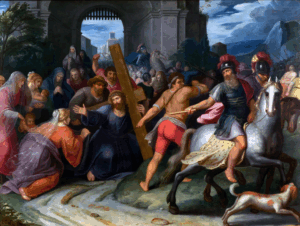Object of the Month: July 2025
Procession to Calvary
Oil on Panel
Otto van Veen
Flemish, c. 1556–d. 1629
Otto van Veen was a classically trained humanist artist or pictor doctus, a concept created by the ancient writer Horace in his Ars Poetica signifying the attempt by artists to regain the social standing of the ancients. Otto van Veen succeeded. A renowned court painter to several rulers, he led the Antwerp art scene, diminishing only when his pupil Peter Paul Rubens returned from his travels in 1608. He paid tribute to Horace by creating two series of emblematic art which coupled Horatian proverbs with an illustrative image. A Romanist painter, he continued the traditions of the church through his work, including this one in M&G’s collection.
Using the usual cast of characters—Roman soldiers, weeping women, Simon of Cyrene, and a jeering mob—van Veen pictures the procession to Calvary just outside the city gate. A woman in the foreground holds up a piece of cloth to Christ who has stumbled under the cross and brought the procession to a momentary halt. St. Veronica offers her veil to Christ to wipe his brow. Traditionally, He accepts her kindness and a likeness of His face appears on the veil when it is returned to her. Scholars debate whether the woman is named Veronica or that the replication of Christ’s “true image”—vera icon—contributed to her name. She is part of a trio of women; the others have children with them, which reminds the viewer that Christ welcomed little children to come to Him. Just slightly behind these women are Mary with clasped hands in her usual blue robe and John, already attentive to her wellbeing.
Van Veen visually divides the scene with the positioning of the cross. On one side is the sympathetic crowd; on the other is the iron hand of Rome. The right side of the panel draws the viewer’s eye to the white horse ridden by a Roman soldier and the muscular figure pulling Christ up the hill with a rope. The dress of this man and the man behind the cross who whips Simon and Christ indicates that they are not part of the military structure of Rome. Instead, they seem to be commoners employed by Rome for the occasion. Combining this fact with the intense, backward gaze of the prominent soldier on horseback creates a personal interaction between the viewer and the scene. The sinfulness of every man compels an atonement be made for a restoration of relationship with God. In the foreground, the open area at this stopping point on the way to Golgotha provides room for the viewer to be included in the picture’s events and to consider which “side” of the scene he will be part of: sympathetic or condemnatory.
Dr. Karen Rowe Jones, M&G board member
Published 2025
Additional Resources:
For additional information on an etching by N. Muxel made after Otto van Veen’s Procession click here.
To see an image of Otto van Veen’s Christ Meeting St. Veronica from the Royal Museums of Fine Arts of Belgium click here.
